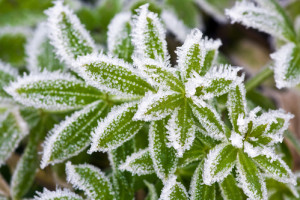Author Archive
The Necessity of Irrigation
You want an awesome lawn. When you invest in landscaping service, you expect your lawn’s greenery — your greenscape — to remain beautiful and awesome for a very long time. Despite the fleeting nature of plants, maintaining a beautiful greenscape throughout the year is very possible. To this end, one of the most important things for you to do is to have an irrigation system installed. Although these systems are often only thought of as something for growing crops, irrigation is actually a necessity for your lawn. This isn’t just a matter of watering your plants either. Let’s take a look at why irrigating your lawn is so important for it’s health.
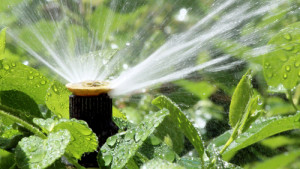
Irrigation Makes Your Greenscape More Durable
Rainwater and hand-poured water only moisturize plants at the surface level. Their roots, however, go very deep into the ground. This means that under normal circumstances, the bottom of your roots are extremely dry. That’s like only dipping your legs into the pool on a 100 degree day, while leaving your torso to be burned by the scorching sun! Such dryness makes it a whole lot harder for your plants to resist tougher conditions, because in addition to having dry roots, they won’t be able to gather up enough water for their plant bodies.
Irrigation solves this problem by collecting water and sending it straight down to your plants’ roots, resulting in a wet, sturdy greenscape.
Irrigation Makes Sure That Your Greenscape Evenly Grows
A bright, healthy lawn can still look patchy. This happens when your lawn gets different amounts of water in each area. When this happens, some plants are bound to grow way faster than others, resulting in an ugly, patchy appearance for your lawn. This sucks!
Irrigating your lawn lets you evenly distribute the water that gets into your lawn. This way, the patches of grass near the patio will look exactly the same as the strips of grass lining the patio.
Irrigation Protects Your Greenscape From Droughts
California isn’t the only place that has had water problems in the past. You don’t have to be in a desert to end up in a drought. In fact, low rainfall can happen just about anywhere — unless you live inside of a rain cloud! When a drought happens, your lawn’s greenscape will be among the first things to be harmed. This is because plants rely on water even more than we do to live long, healthy lives.
A good irrigation system can fully protect your lawn’s plants from a drought by spraying water on the plants regularly, even if it doesn’t rain all season.
Irrigation Reduces Your Workload
Even if you have two green thumbs and green big toes, maintaining a lawn isn’t easy. One of the hardest parts of this process is making sure that your plants get all of their proper nutrition. An irrigation system handles the lion’s share of the workload needed to keep your plants healthy, because they will provide them with all of the water that they need on a daily basis. In fact, if your lawn has plants that crave more water than usual, your irrigation system can send plenty of water to your plants multiple times per day.
Irrigating Your Greenscape Takes The Worry Out of Lawn Care
Having an awesome lawn is your goal. Achieving that goal shouldn’t be such a hard thing to do. By investing in a lawn irrigation system, you will make sure that your lawn is absolutely awesome at all times. Contact us to learn more about the benefits of lawn irrigation, and what types of systems are available.
Building a Rock Garden: Everything You Wanted To Know
Rocks gardens, sometimes called alpine gardens and less commonly rockeries, are structures made from stones, rocks and boulders that you can build around your garden populated with perennials and annuals to really set it off.
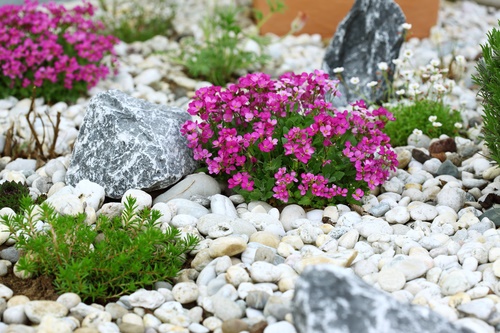
Rock Garden: What You Should Know
Usually rock gardens are role players or a kind of supporting cast for the main players that are your perennials, biennials and annuals.
The exception would be some Zen gardens in Japan that are designed almost exclusively from rocks, boulders and sand and designed to open the doors to enlightenment…but for now we’ll keep both feet squarely planted in the real world.
- Why Create a Rock Garden?
A lot of homeowners want to know right off the bat why they should be investing their time and energy into a rock garden in the first place.
That’s a great question and the answer really boils down to aesthetics and practicality. On the aesthetics point, rock gardens can lend a rugged air to your garden and make a very natural complement to your roses and annual flowers.
The other side of the coin is practicality: Rock gardens make a lot of sense if you’re working with an area that hards to reach with a lawnmower and provide regular maintenance to.
Many homeowners also consider putting up a rock garden to make a clearer demarcation line between an outdoor patio area, mulch and their garden proper. This really lends a lot of perspective by creating a more dynamic environment and allowing you to naturally get a wider color palette into your backyard.
- Where to Plant Rock Gardens?
You definitely want to select the right rocks and stones for the job when it comes to creating a rock garden that naturally allows you to find the optimal balance between earth tones and flowering brilliance.
For instance, if you have a lot of outdoor space in your backyard and a slight undulating up (or down) that might call for a staircase comprised of stone slabs or a tiny pebble walkway, then you could try something like this to lend more perspective and work with the existing elements.
You can even light the way with sconces along your pathway and combine stone slabs with more petite rocks forming your walking path. A few low maintenance yet vibrant perennials like dahlias and creeping thyme can work great running along the side too.
If you’re dealing with a really steep slope, then working in some larger rocks or complementing preexisting boulders can make a great retaining wall or framing device for a rock garden down below. A combination of flowers, shrubs and chips can set things off underneath.
You might also try erecting a rock garden near hard-to-reach areas running along a fence or hilly areas as these really are the perfect excuse for building up a rock garden and turning lemons into lemonade with your next outdoor project.
- Can I Still Go Zen?
You absolutely can still incorporate aspects of a traditional rock garden into your next backyard project!
The Zen Temple of Ryoanji means The Temple of the Dragon at Peace, and it’s easy to see how it got that name: Using open space to its advantage, Zen rock gardens are peaceful reposes and typically only call on a few rocks, pebbles and moss to achieve their tranquilizing effects.
To create your own Zen rock garden use edging stones, pebbles and prune your plants to fit the aesthetic you’re going for. For help getting there, contact us the gardening professionals.
Flower Bed Ideas – A Few Good Tips You Should Follow
Flower beds are one of the most convenient ways of sprucing up your outdoor decor and beautifying your entire yard.
Planting a flower bed is also a labor of love for millions of homeowners who already have the knack (and experience) for it; for those who don’t, the rest of this post if for you.
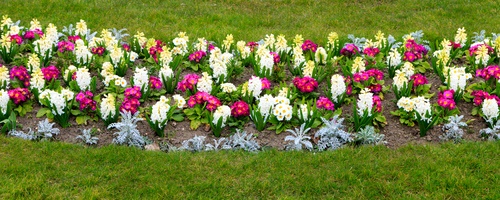
And if you’re still worried about your garden or you feel like your entire yard could benefit from aeration, then don’t hesitate to contact us your lawn experts. Now, let’s get started:
Tips for the Perfect Flower Bed
The perfect flower bed brings together form and function by applying a few simple tips in order to create a whole that’s greater than the sum of its parts.
- Focus on Framing
Part of the “form” part of creating the ideal flower bed for your home is going with a melange of perennials, annuals and shrubs for variety and framing.
In the same way that what’s in the background on a stage set can help to frame all the action going on in the foreground, you want a “framing device” in the back of your flower bed to draw your eye into the action.
A good rule of thumb is to plant tall perennial plants in the back of your garden to get the most out of everything going on upfront.
If you’re on a tight budget or you want to make a simpler landscaping project for yourself, then you can always put shrubs behind your perennials and annuals as well.
- Blend Perennials and Annuals
Annual flowers cycle through the germination, seeding, flowering and expiration process in one single year whereas perennials are able to grow from one year to the next with an off-season of dormancy in the winter.
The good news is that perennials like roses, daylilies, and peonies tend to play nice with annual flowers like marigolds and zinnias when it comes to finding the right balance between earth tones and more vibrant colors for your home garden.
- Combining Earth Tones and Vibrancy
In particular, the pink of a blossoming peony tends to work beautifully with the vibrant red of most roses. Marigolds and zinnias can also work well together if you’re looking to combine more tropical orange and yellow tones into your next flower bed.
Zinnias are actually easier to cultivate than most annuals and come in a myriad of colors that can make any garden really pop and dazzle guests.
You can find zinnias in purple, crimson, rose and scarlet to suit your tastes and make a flowing color combination with actual roses or even peonies when it comes time to get going.
Putting on the Finishing Touches
Once you know the kind of look that you’re going for and how to frame it with shrubs and/or tall perennials, then you want to move onto decorating fences or surrounding wall structures.
For this the beautiful pink and purples of an annual flower like the climbing snapdragon or greens, purples and yellows of passion flower can work very well.
Peony and roses upfront with climbing snapdragon or passion flower snaking along overhanging structures are an awesome want to frame your garden as well as beautify your home and complement your other landscaping efforts.
For help with aeration, irrigation, gardening or regular landscaping maintenance, or just to find out more tips like these, get in touch with DK Landscaping today.
Practical Winter Gardening Advice For Homeowners
Are you looking to get the most out of your garden year-round? The good news is that a lot of common shrubs, plants and flowers do well against frost in more intolerant hardiness zones.
So, what is a hardiness zone and how does it affect your winter gardening? A hardiness zone is a map put out by the USDA that basically tells gardeners which plants work best in which climates.
General Winter Gardening Tips
What’s important to realize upfront is that plants that can withstand the frost usually enter a period of relative dormancy to survive the winter months.
So, what are some things that you can do to make this transition easier on your hardy plants and perennials?
- Remove Waste
Removing any refuse, blackened-out stems and leaves from annual flowers is a great way to lessen the possibility of pathogens in the soil harming your hardy plants during their dormancy period.
- Install a Cold Frame
A cold frame (more on this below) is a raised wooden structure with a plastic cover that can further help protect perennials and hardy bulbs against the elements.
Even when plants are considered perennial, they still might benefit from the protection that a cold frame offers – especially if the temperatures drop to below zero with the wind chill.
- Apply Winter Mulch
On the topic of mulching, you should also realize that a lot of your summer mulch may have already decomposed at the start of winter.
Laying down a fresh layer of winter mulch goes a long way towards protecting your hardy plants and underlying soil during winter.
http://gardening.about.com/od/winterinthegarden/a/WInter_Mulch.htm
You can actually work with the elements by turning the fall’s fallen leaves into a winter mulch that will stay frozen and protect your garden.
Winter Gardening Devices to Consider
In addition to paying attention to your hardiness zone, devices like a quick-hoop system, floating row cover, or cold frame can greater buffer those punishing winter winds and cold temperatures.
- Quick-hoop system
Quick-hoop systems are also called low tunnel systems, and by whatever name these structures have been known to protect your plants from winter’s frost.
Annual and perennial hardy plants are able to survive the rigors of winter, frost and heavy winds. This means that calendula, foxglove, pansies and peonies require little maintenance during winter beyond the protection from a low tunnel system.
Hardy plants like these require less light to develop fully and can withstand hard frosts. Hardier plants only require around four hours of sunshine every day and grow best in cooler conditions.
If you’re living in an area that gets less frost, then many of these plants can be grown throughout the winter months. It’s recommended, though, that you plant hardy plants when the soil temperature is around 40 degrees fahrenheit – perhaps in very late winter or very early spring.
Low tunnels provide more protection against cold temperatures, frigid winter winds, and more relative humidity than the surrounding environment.
http://www.motherearthnews.com/organic-gardening/low-tunnels-quick-hoops-zmaz09onzraw.aspx
- Floating Row Cover
Floating row covers are probably the most simple and straightforward form of winter protection.
Putting your hardy plants under a thin film can protect against cold, harsh winds and potential hail damage while allowing an extended growing season for hardy plants and perennials.
- Cold Frame
The most popular kind of cold frame is a portable cold frame encased in wood with a durable plastic cover to protect against the elements.
That said, there are three types of cold frames (pictured here) that can extend your growing season well past frost. For more winter gardening tips, contact the professionals at Xeriscape today.
Lawn Treatment Tips to Prevent Crabgrass & Dandelions
Nothing ruins a lawn’s uniform, well-manicured appearance like dandelions and crabgrass. These invasive weeds make a lawn look shabby and poorly maintained — and when they set up shop, they can be a nightmare to remove. Thankfully, these lawn treatment tips will help you prevent crabgrass, dandelions and other unsightly weeds from taking residence in your yard.
Keep Your Grass Long
Crabgrass seeds in particular germinate with exposure to sunshine. One of the most useful lawn treatment tips you can follow is to set your lawnmower’s blades so they’re as far off the ground as possible. You’ll have to mow your lawn more often to keep it looking good, but the resulting tall, thick grass growth will shade the ground better, and keep crabgrass seeds from germinating.
Fertilize Your Yard
Make sure you fertilize your lawn at least once a year. This is one of many lawn treatment tips that you should be following, even if you don’t have a weed problem! It’ll help your lawn grow in thicker and stronger, which will allow your grass to compete better with any dandelions or crabgrass that tries to take root.
Reseed Your Lawn
Weeds typically grow in patchy areas of your lawn, where they have little competition from your grass. If you’re seeing worn spots in your yard, most lawn treatment tips advise you to reseed your lawn in fall. Make sure you tear out all existing weeds, or use herbicide on them, so that your grass can take root and thrive. Once the new grass is established, it’ll be able to deny any invading weeds the chance to take root.
Water Your Lawn Deeply
Most weeds thrive on infrequent, shallow watering. One of the most useful lawn treatment tips you can follow is to water your lawn seldom — on the order of once a week — but deeply. Your grass appreciates this better than your weeds do. It’ll give your lawn the chance to soak up all that delicious moisture, and build a strong root network that can resist invaders. As a bonus, that healthy root network will be more resistant to high temperatures!
Use a Pre-Emergent Herbicide
Many people may balk at applying herbicides to their lawn, so this is one of the lawn treatment tips that’s most useful if your lawn continues to suffer from weeds, after you’ve taken other options. Pre-emergent herbicides are highly specialized weed killers, so they won’t kill existing weeds effectively. Rather, they keep seeds from germinating, so they work best when applied in early spring or late autumn, and only when you’ve successfully followed other lawn treatment tips to remove crabgrass and dandelions from your yard. When you’re choosing a herbicide, always be sure to follow all instructions on the package carefully.
Removing noxious weeds like crabgrass and dandelions, when they’re established, can be a real pain. An ounce of prevention is worth a pound of cure, so follow these lawn treatment tips and put bothersome weeds out of your mind!
Gardening Advice from a Landscape Maintenance Company
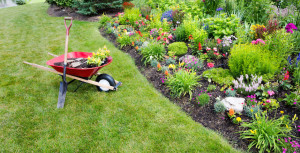 Most people expect three things from their landscape: for it to look good, for it to require little maintenance, and for that maintenance to be inexpensive.The reality is that to keep your garden looking green and healthy, you will have to invest a lot of time, money and effort. Serious gardening may not be easy if you have a busy life. However, with a little planning and the right advice, it is possible to reduce gardening costs while still having an aesthetically pleasing garden. In order to get the most out of your gardening time on the weekends, consider the following tips:
Most people expect three things from their landscape: for it to look good, for it to require little maintenance, and for that maintenance to be inexpensive.The reality is that to keep your garden looking green and healthy, you will have to invest a lot of time, money and effort. Serious gardening may not be easy if you have a busy life. However, with a little planning and the right advice, it is possible to reduce gardening costs while still having an aesthetically pleasing garden. In order to get the most out of your gardening time on the weekends, consider the following tips:
- Understand Your Garden
Before you decide to add anything new to your garden or to make any big changes, look at what is already there. Pay attention to the weather, as well as to the light and soil in your yard. Look at the types of plants that are thriving under the conditions present on your property. When you go shopping for new plants, look for ones that flourish under those same conditions. - Put in a Few Trees
Trees are an excellent addition to your property and can help to increase its value. Mature trees not only provide a degree of privacy for your home, they can provide protection for plants lower to the ground as well. Trees last for a long time and require relatively little maintenance. - Choose the Right Plants
If you are a busy person without much time for gardening, you may want to focus on low maintenance plants. It is important to remember that the meaning of a term like “low maintenance” can differ from person to person. Plants that are considered by others to need little maintenance may actually require more gardening time than you are able to invest. If you have limited time for gardening, consider hiring a professional to handle your landscape maintenance. With their help, you may be able to get plants that require more effort. - Take Out the Tough Weeds Prior to Planting
When you are putting in a new landscape, preparation makes all the difference. By carefully preparing the soil, you can substantially reduce the amount of time and effort that you spend gardening. Remove the top layer of sod in the location that you intend to use for your garden. Completely remove annual and perennial weeds from the area as well. Till the soil and let the sun dry out any remaining weeds. Give it a week before tilling again. - Choose Plants of the Right Size
Look at the tags on your plants to find out how large they will get. Avoid crowding your garden beds and pay attention to the plants’ growth tendencies rather than try to restrict them. - Pruning
Good gardening involves pruning your plants annually to maintain their health and to keep your garden looking neat.
Landscape and Garden Design Tips For New Homeowners
Landscape and garden design is top priority as you’re excited about your new home. You can’t wait to finish decorating and furnishing every space in your home, including your lawn and garden. However, when you first start considering what the perfect layout for your garden would be, the options and work involved can seem overwhelming. Fortunately, you can simplify the entire garden design process by understanding how it works. In order to get your landscape and garden design right, keep the following basic tips in mind:
Don’t Brainstorm Your Landscape and Garden Design Ideas in a Vacuum
One of the biggest mistakes you can make with garden design is to sit in an empty room and try to come up with ideas. Successfully designing a garden requires inspiration; for this, there is inspiration all around you. In particular, there are three sources that you should pull inspiration from:
Nature — Naturally beautiful landscapes allow you to see how garden life can flow on its own with the right setup
Professionals — Looking at beautifully laid out parks, checking out professionally landscaped homes, and consulting with a landscaper are all great sources for landscaping ideas
Your neighborhood — Walking around your area and adding features from your neighbors’ garden designs that you do like — and avoiding the features that you don’t like — can really help you develop your own design, especially since the homes in the area will have some similarities to your own
Think Function and Form for Your Design
You want to be able to enjoy your outdoor space as your own little garden oasis. For this, you need to consider both form and function (you can’t create a garden oasis feel without the right design, but you can’t enjoy your garden oasis if your design hasn’t left you with any room to relax in it).
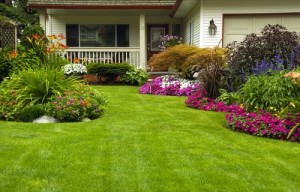
Create a Realistic Design Budget
Garden design budgets can vary drastically. If you approach your design haphazardly, you could find yourself turning your pockets inside out before the job is even half of the way done. On the other hand, you could end up missing on some outstanding garden design elements that you could easily afford if you approach the project cheaply with no real budget in mind. Avoid these types of issues by setting a realistic budget before you begin with your final plans. This way, you know what you can really afford to do. Also, because sudden expenses can occur, be sure to give your budget an extra 10%-20% emergency cushion.
Another issue to bear in mind is water savings and homeowners should set up a design that saves water and ultimately money. The state of California has laws in place in regards to water irrigation in order to protect and efficiently manage the county’s water supply.
Decide What You Can and Can’t Do On Your Own
Even if you have a green thumb, don’t simply assume that you can do it all. Installing certain fixtures, plants, etc into a garden the right way requires a team of professionals and the right equipment. Consult with a professional landscaper to discuss your options here.
Write Your Design Plans Down
Once you have all of your garden design plans in place, you need to make sure that you stick to them — and that you’re really going to like them. To this end, you should write everything down in two forms: prose and sketch. Writing everything you need down will keep your design plans in perspective with your budget and drawing a picture will give you a good depiction of how everything will actually look when you’re all done (the real thing doesn’t always match up with what’s in your head. If you can’t draw, then have a professional landscaper help you develop the image.
You’re Not Far From the Design of Your Dreams
Now that you know how to approach landscape and garden design, it’s time to get the process started. Reach out to us for a consultation as we’re here to help you get started.
Garden Design for Clay Soils
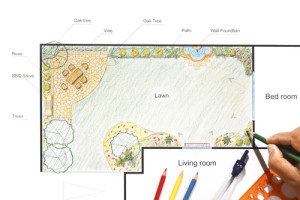 Clay soil is definitely an acquired taste for most gardeners, yet you might start swearing by clay soil once you hear some of the benefits listed below. First, though, what the heck is clay soil and how can it benefit your garden?
Clay soil is definitely an acquired taste for most gardeners, yet you might start swearing by clay soil once you hear some of the benefits listed below. First, though, what the heck is clay soil and how can it benefit your garden?
Clay Soil Vs. The Competition
Generally when you walk into a nursery, outdoors department or speak with a landscape maintenance company, you might be steered more towards silt soils or loam soils before clay. That’s because clay soil is composed of tiny plates or granules that can harden over time.
You’ve no doubt had the experience of plunking your shovel down into the ground, ready to get your garden going in the spring, and run up against clay. In spite of its hardness, though, clay soil is great for retaining moisture, nourishing your garden as well as retaining nutrients and fertilizers between individual clay particles.
Loam, relatedly, is a combination of clay, sand and silt and is very versatile, moldable and just easy for even inexperienced gardeners to work with.
Benefits of Clay
Part of the reason that loam soil is so moldable, to our main point, is that loam contains clay. The clay in the loam ensures that what you’re working with clumps into granules whereas the silt and clay components of loam help to retain moisture and nourish the plants in your garden.
Clay soil works wonderfully for annuals as well as perennial plants since the clay allows these plants to get a firm (and nourishing!) hold with their roots. The grip that perennials and annuals get with clay can withstand otherwise harsh humidity and temperature changes.
In short, clay’s fantastic as a garden design foundation since it provides a hearty root structure and allows plants to withstand harsh conditions. Moreover, you won’t need to water or fertilize as much with clay as with other soils. All good things.
Working with Clay Soil
Clay soil as a garden design foundation can accommodate a pretty wide range of shrubs, climbers, conifers and trees. Everything from popular conifers like ginkgo biloba and a deciduous evergreen like cotoneaster to rosa and fuchsia shrubs makes a great complement to clay soil.
To provide even more nutrients for these clay-compatible shrubs and conifers try adding a light mulch to your garden. Leafmold, composted bark and long manure work especially well with clay soil in terms of providing an easy-to-work-with mulch that does wonders for your plants.
Mulching Your Clay Foundation
When you actually get down to planting, mulching the plants up to three inches is a good idea for a few reasons.
Just a few inches down allows the right amount of moisture to hit your plants’ roots while tamping down weed growth and providing shielding from the elements.
One problem that people have with clay soil is that they sometimes overwater. Remember that clay soil retains water and moisture better than other garden foundations and, therefore, doesn’t need around-the-clock watering.
You’ll know that you’re doing too much watering when you notice a lot of the plants visibly retaining water and you notice globs of water on the clay surface the next day. These would both indicate that it’s time to cut back and let clay soil work its magic.
Creating the Perfect Garden
If you understand how clay’s small granules retain moisture and you know not to overwater, clay can offer a ton of benefits beyond more favored soil types.
You might consider planting eucalyptus trees, gorgeous flowering plants like bergenias and some of the conifers mentioned above for the perfect garden design. Contact Xeriscape today to get started.
What is Drip Irrigation and Its Advantages?
 You may have heard the phrase “drip irrigation” thrown around and not been able to make heads or tails out of it. Fortunately, drip irrigation isn’t that complicated a concept to really understand.
You may have heard the phrase “drip irrigation” thrown around and not been able to make heads or tails out of it. Fortunately, drip irrigation isn’t that complicated a concept to really understand.
What is Drip Irrigation?
Irrigation is simply the process of artificially applying water to land or soil in order to stimulate growth. Farmers and property owners around the country rely on irrigation to create fuller crops or more appealing lawns.
Drip irrigation, also referred to as trickle irrigation, is a method of irrigation that’s extremely environmentally friendly. This is because drip irrigation applies water directly to the plant’s roots, root zone or the soil itself.
The fact that drip irrigation sends water directly to the surface that needs it most with a plastic device known as an emitter is especially relevant today. Parts of California, Texas and the Southwestern United States are experiencing their worst droughts in years, so a more intelligent irrigation system is a must.
Drip irrigation actually uses tubes and hoses to efficiently send water to a plastic emitter, which in turn sends water directly onto the plant’s roots or soil’s surface. This whole process saves a ton of water and fertilizing material.
More Advantages of Drip Irrigation
Even for farmers or property owners who like using fertilizer, drip irrigation allows you to retain nutrients while using less fertilizer – all the while achieving even better results!
Drip irrigation also allows you to keep the moisture level constant between the root zone and field capacity. And just to clarify, the term “field capacity” is simply the amount of moisture in the soil after the excess water has drained away.
Here’s some more good news for anyone who wants to try out drip irrigation – drip irrigation ensures less soil erosion and fewer weeds grow on your property. For farmers, this is a huge boon and directly increases their crop yield and profits. For regular property owners, this leaves your lawn looking crisp, green and lush.
For those concerned about rising energy prices, you’re bound to like drip irrigation as well. The process of drip irrigation is extremely water efficient and operates under less pressurization than most other types of pressurized irrigation, which translates to money saved on utility bills.
Because of drip irrigation’s higher efficiency, you’re also talking about smaller labor costs compared to other forms of irrigation.
Control in Your Hands
Due to the fact that controllable amounts of water make their way to the soil’s surface or the roots of plants, drip irrigation puts far more control into your hands.
You can regulate the amount of water that gets sent to each individual plant or section of your property by regulating the water pressure going to each output nozzle.
Drip irrigation is saving you water all the while as well since drip irrigation is estimated to use less than half the water of conventional sprinkler systems. So, you’re using less water and experiencing less nutrient runoff and soil erosion: This is definitely a recipe for long-term success.
Drip irrigation can even be set to a timer so that you can fully automate the watering process or cut it on/off at your discretion throughout the day. A drip irrigation system is highly adaptable and can be changed literally overnight to better suit the changes taking place on your property.
You can find out more about drip irrigation or set up an appointment by getting in touch with a Xeriscape lawn care professional today.
Xeriscape Landscaping Ideas for Easy Gardening
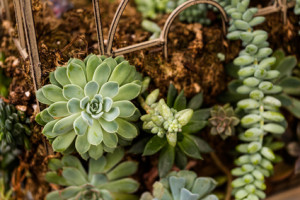 Xeriscape is a type of gardening that focuses on conserving water. You typically won’t see any lush green lawns; instead, xeriscape yards and gardens are full of local and drought-resistant plants, and typically involve creative uses of windbreaks and drip irrigation. They’re gaining popularity not just for their eco-friendliness, but because they’re very easy to maintain.
Xeriscape is a type of gardening that focuses on conserving water. You typically won’t see any lush green lawns; instead, xeriscape yards and gardens are full of local and drought-resistant plants, and typically involve creative uses of windbreaks and drip irrigation. They’re gaining popularity not just for their eco-friendliness, but because they’re very easy to maintain.
This school of gardening breaks a lot of the rules that many landscapers follow. It can be tricky to know where to get started, but here are a few ideas.
Research Xeriscape and Use Local Plants
We can’t advise you about what plants you should be using, because it’s particular to your region and your aesthetic tastes. Ideally, you want to rely as much as possible on rainfall, and the best way to do that is to use drought-resistant plants that are adapted to your area. Exotics are typically harder to maintain, and invasives often suck up water. An added benefit to choosing local plants is that local wildlife will seek your xeriscape garden out!
So head to your local library, check online, or go through a local greenhouse and ask questions of the staff there. Landscaping 101 applies here: be sure you’re choosing plants that will thrive in your soil’s pH, and with the different amount of sunshine your xeriscape gets. Remember to choose a variety of colors, and try to choose plants that will bloom over the course of the year rather than all at once.
Compost Before You Plant
After your plants are in the ground, it can be tricky to compost your xeriscape. Instead, add the compost while you’re prepping the soil for your plants. This doesn’t just make the soil richer — it also helps it retain moisture.
Permeable Paving
Asphalt, tile, or other paving surfaces catch water and cause it to puddle and eventually evaporate, where it’s lost. This “hardscaping” can also become very hot in the sun, which affects moisture absorbtion and can make your plants wilt. Using gravel, sand, or a comparable paving material on your paths lets water seep down into the soil to water your xeriscape plants.
Grade on a Curve!
Try adding a slight grade, or even terracing, to your xeriscape garden. Remember, it doesn’t help if the water puddles, or runs out to the street. You want the water to flow gently downhill, so that it trickles over the surface of the soil and is absorbed.
Use Mulch
Mulch heavily around your plants! Three to four inches is enough to keep the soil’s moisture in, and as the mulch’s bottom layers degrade they fertilize the soil. While gravel is another xeriscape option and it works great, some people find that it makes their gardens look drier and more like a desert, compared to how mulch looks.
Rainwater Harvesting and Clever Irrigation
Even with clever xeriscape techniques, you will still need to water your garden. This is particularly important for plants that are young or just getting settled, because they’re still building their root systems. Collect water to irrigate by hooking a rainwater barrel up to your gutter. Make sure you water during the cooler evening hours, and try using a soaker hose or an automated drip irrigation system. These saturate the soil, so as little as possible is lost.


